
Surveys
DJC.COM
July 12, 2001
Building a greener future on Bainbridge
Special to the Journal
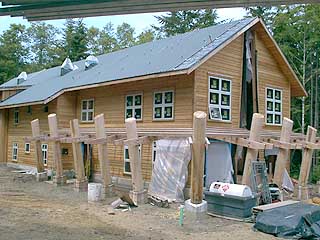
Photo by Darrell Howe/Rafn The metal roof of the sleeping lodge will support photovoltaic panels for energy collection. |
While teams of architects, engineers and educators are involved with the construction of the $53 million Puget Sound Environmental Learning Center, the real design decisions are being made by less conventional partners: children and the environment.
There’s a lot of money at stake to design a project according to kids’ desires and nature’s rules, but in reality the 255-acre educational campus caters specifically to both. For Debbi and Paul Brainerd, who founded the learning center in 1998, it made sense to allow children and natural resource conservation to dictate the function and layout of the learning complex.
“I wanted to create a magical place for kids where they can learn about the place they live. Given that, it makes sense to let kids have a major voice in the design of the learning center,” Debbi Brainerd said.
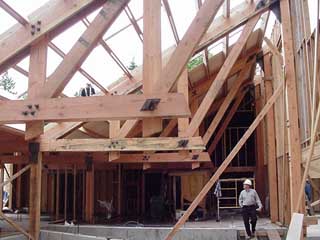
Photo courtesy of Mithun Partners Roof trusses in the dining hall. |
In 1997, the Brainerds put up $5 million to purchase the land, which was slated for use as a housing development. Debbi Brainerd came up with the idea to use the land for something close to their hearts: children, education and the environment. So she created the idea of the Puget Sound Environmental Learning Center.
Since then, they have contributed another $20 million to help cover the $33 million in construction costs and set aside a $10 million operations endowment for the center. They are raising the additional funds to complete construction and to provide a $5 million scholarship endowment for kids from underserved populations.
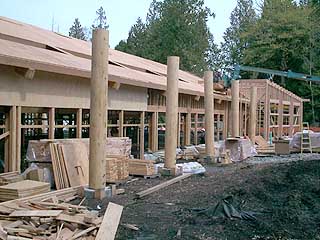
Photo by Darrell Howe/Rafn Peeled beams are being used on the exterior of the administration offices. |
When completed next year, the learning center will provide outdoor, hands-on science- and humanities-based education programs to more than 8,000 students, teachers and families. Of those 8,000 people, more than 4,000 children throughout the Puget Sound region will attend four-day education programs during the school year.
Tucked above the former site of the Port Blakely Mill on south Bainbridge Island, the learning center campus sits within a watershed of forest and wetlands — a different world compared to the urban landscape many students call home.
The practice of sustainable design for the project began three years ago when Debbi Brainerd and the design team tried to figure out the best placement of the buildings.
Many factors had to be taken into account, such as sunlight and the location of buildings around sensitive wetlands and trees. Constructing the buildings in the wrong location could have hampered the use of natural energy and heat producers, such as photovoltaic and solar water panels, in addition to harming the ecosystem they were trying to teach the public to protect.
So the engineers and contractors, headed by Mithun Partners, the architectural firm best known for its design of the flagship REI store, used a set of detailed maps and computer models to determine the ideal building location while minimizing the impact to the site.
“Every time we did something, we asked ourselves what’s the best decision for kids and for the environment instead of what’s going to look good?” said David Goldberg, the project designer at Mithun.
The site layout was just the first of a long list of “green” design and construction practices used throughout the project.
When students stroll through the campus’ main center, they will walk on recycled-content concrete and reclaimed wood flooring. The roof truss overhead will be a 92-foot wooden beam salvaged from a Montana mine. In the learning studios, students will perform projects on countertops constructed of recycled yogurt containers, crushed sunflower shells and recycled concrete while standing on floors made of cork, bamboo, recycled rubber and recycled concrete.
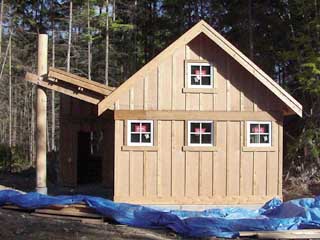
Photo courtesy of Mithun Partners Siding on the graduate cabin has been left untreated to reduce off-gassing. |
In addition, the buildings will go without typical heating and air conditioning. Instead, the learning center’s buildings will use strategically placed windows that will trap the sun’s rays inside for heat or allow cooling winds inside for ventilation.
This is just a short list of some of the easily applied sustainable concepts. But the project uses more intensive practices that are attracting the attention of people and organizations within the environmental design industry, such as the U.S. Green Buildings Council, which sets the standards in sustainable building design.
One instance is how wastewater will be treated on site. Every time someone flushes a toilet or uses a sink faucet, the water will flow to a natural treatment center, called a “living machine.” Up to 3,500 gallons of water each day will work its way through settling tanks, where solids are removed, and into special tanks where plants, snails and other microorganisms eat away at the remaining material, said Chris Webb, a principal and professional engineer with 2020 Engineering.
The treated water will be just as clean, possibly cleaner, than municipally cleaned water. And after it is treated, sun-powered blowers and pumps will draw the water back into the bathrooms where it will be used to flush the toilets. This will save up to 1,750 gallons of water each day, according to Webb.
Learning center officials and architects also are being creative about finding building materials. Debbi Brainerd and Mithun have demanded that the contractor, Rafn Co., use certified building materials as much as possible, such as wood from sustainable forests.
The project even takes recycling to a new level. About 12 acres of land had to be cleared of cedar, alder and maple trees and scrub to make room for the buildings. Instead of giving away the lumber, they sent the wood to a mill where siding and interior trim was produced and used throughout the campus.
Following Mother Nature’s lead on the project hasn’t been easy. Since many of these unconventional materials are harder to find and cost more than standard construction supplies, learning center officials began to face time and cost limitations. The project could have taken conservation and sustainability to an even higher level, but it became cost prohibitive, Goldberg said.
Yet, when it is completed in fall 2002, the learning center will be “one of a kind,” Goldberg added.
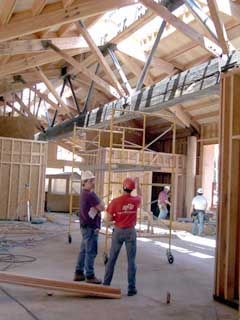
Photo by Darrell Howe/Rafn The Great Hall features a 92-foot wood beam salvaged from a Montana mine. |
“It’s been a very challenging task and a careful balancing act to get all of these pieces to fit together. I think we are accomplishing our job and will have a center that sets the standard in sustainable design,” said Dana Warren, project manager of the Puget Sound Environmental Learning Center.
Business interests are even taking notice, Warren said. The Pella Corp. recently struck a deal with the learning center and lowered its prices so it could fit the entire center with energy-efficient windows.
When it opens, the learning center will become more than just a series of buildings where students spend the day attending class and the nights resting — it will become a living laboratory used for learning.
For example, by observing the living machine, the tertiary wastewater system, students can learn about microbiology. By studying the building design they can learn about the dynamics of air temperature and movement.
“The purpose of the center is to teach children about the place in which they live and their relationship to it,” Debbi Brainerd said. “If we do things right — these kids will grow up to be stewards in their own communities.”
Jonathan McKernan is a freelance writer who lives in Seattle. He recently moved from Chicago where he worked as a general assignment print reporter for seven years.
Other Stories:
- Pesticide-free parks teach new lessons
- Water metering: the debate trickles on
- Studies sniff out Tacoma smelter plume
- Tree investment brings cities many happy returns
- From wood preservation to site remediation — the Cascade Pole cleanup
- New rules for birds, bogs and bulldozers
- Isolated wetlands ruling creates confusion
- Environmental metamorphosis on the Duwamish
- Mitigation banks balance habitat, development
- New Pin Foundation minimizes site impacts
- Bringing a city stream back to life
- Knitting a trail of green
- Stormwater problems? Put a LID on it
- More brownfield incentives in the pipeline
- SEPA document trends since GMA and regulatory reform
- Construction faces new foe: toxic mold
- Helping environmental groups to get wired
- Frequently asked ESA questions
- Muddy waters: The new 4(d) salmon rule
- Global climate change starts at home
- At EPA, next 4 years won’t be boring
- Dams vs. fish? Mediate it!
- 'House calls' help firms to conserve
- Power users, producers turn toward the sun
- Seattle goes climate neutral
- Bamboo’s popularity shoots up
- Tiny town recycles Goliath proportions
- MTCA revisions take effect Aug. 15
- Environmental education: Knowing what’s in your backyard
- Bear Creek roars again
- Shedding light into the permit ‘black hole’
- UW Bothell — a wetland lesson in the making
Copyright ©2009 Seattle Daily Journal and DJC.COM.
Comments? Questions? Contact us.